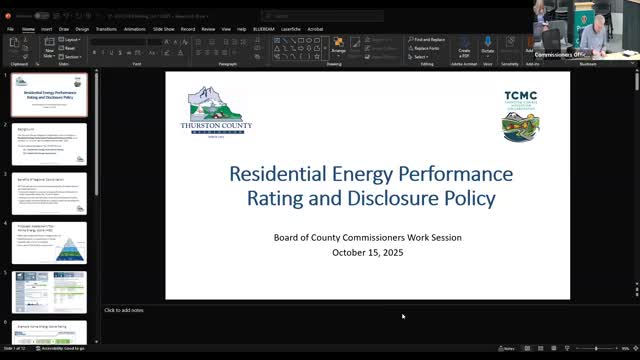County staff seeks public outreach on Home Energy Score ordinance; board directs wider stakeholder engagement
October 16, 2025 | Thurston County, Washington
This article was created by AI summarizing key points discussed. AI makes mistakes, so for full details and context, please refer to the video of the full meeting. Please report any errors so we can fix them. Report an error »

Rebecca Harvey, Climate Mitigation Senior Program Manager, told the board the Home Energy Score (HES) model ordinance would require sellers to provide a nationally standardized 1–10 energy score at time of listing, plus a link to a detailed report, and that the program is intended as an educational disclosure to help buyers compare homes and encourage voluntary efficiency upgrades.
Harvey said the proposed HES ordinance is the product of more than two years of work by the Thurston Climate Mitigation Collaborative and related stakeholder engagement; the county coordinated the draft with neighboring local jurisdictions in Lacey, Olympia and Tumwater with the goal of a regionally consistent approach. She said the rating takes about an hour to complete and typically costs $150–$300, and that the ordinance would not require homeowners to make improvements — it provides recommended upgrades and estimated savings.
Stakeholder and workforce issues: County staff said there are currently no certified Home Energy Score providers in Thurston County, and the policy would include workforce development and training to build local capacity; the county also outlined estimated first‑year impacts under a moderate scenario (about 2,800 homes rated across the county and an estimated 568 voluntary retrofits in year one). Staff estimated a one-time launch cost for a regional supporting program at about $100,000 and annual maintenance near $25,000; those costs could be shared across jurisdictions if several adopt the model.
Board direction: Commissioners asked about applicability to multifamily housing (the current HES tool applies to single detached homes through fourplexes, not stacked multifamily) and workforce availability; several commissioners said they would like a broader public outreach effort before a formal public hearing. CPED staff recommended outreach to the broader community and to real‑estate professionals in January–February 2026, followed by return to the board to set a public hearing. Commissioners gave staff direction to proceed with the broader outreach and report back with findings and recommended next steps.
Ending: Staff said they will coordinate outreach early in 2026, monitor parallel work in the cities (Olympia, Lacey, Tumwater), and return to the board with summary findings and recommended timing for a public hearing. The draft model ordinance and supporting materials were available in the board packet.
Harvey said the proposed HES ordinance is the product of more than two years of work by the Thurston Climate Mitigation Collaborative and related stakeholder engagement; the county coordinated the draft with neighboring local jurisdictions in Lacey, Olympia and Tumwater with the goal of a regionally consistent approach. She said the rating takes about an hour to complete and typically costs $150–$300, and that the ordinance would not require homeowners to make improvements — it provides recommended upgrades and estimated savings.
Stakeholder and workforce issues: County staff said there are currently no certified Home Energy Score providers in Thurston County, and the policy would include workforce development and training to build local capacity; the county also outlined estimated first‑year impacts under a moderate scenario (about 2,800 homes rated across the county and an estimated 568 voluntary retrofits in year one). Staff estimated a one-time launch cost for a regional supporting program at about $100,000 and annual maintenance near $25,000; those costs could be shared across jurisdictions if several adopt the model.
Board direction: Commissioners asked about applicability to multifamily housing (the current HES tool applies to single detached homes through fourplexes, not stacked multifamily) and workforce availability; several commissioners said they would like a broader public outreach effort before a formal public hearing. CPED staff recommended outreach to the broader community and to real‑estate professionals in January–February 2026, followed by return to the board to set a public hearing. Commissioners gave staff direction to proceed with the broader outreach and report back with findings and recommended next steps.
Ending: Staff said they will coordinate outreach early in 2026, monitor parallel work in the cities (Olympia, Lacey, Tumwater), and return to the board with summary findings and recommended timing for a public hearing. The draft model ordinance and supporting materials were available in the board packet.
View full meeting
This article is based on a recent meeting—watch the full video and explore the complete transcript for deeper insights into the discussion.
View full meeting
